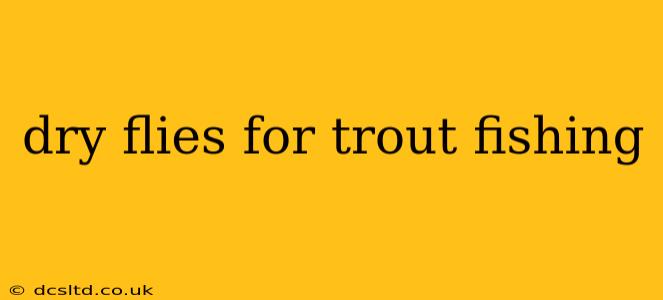Dry fly fishing for trout is a rewarding and challenging pursuit, demanding a keen understanding of both insect life cycles and the subtle nuances of presentation. This guide delves into the world of dry flies, exploring their types, effective techniques, and crucial considerations for successful trout fishing.
What are Dry Flies?
Dry flies are artificial lures designed to imitate the surface-dwelling insects that trout feed upon. Unlike wet flies, which are fished submerged, dry flies float on the water's surface, mimicking the natural behavior of insects like mayflies, caddisflies, and stoneflies. This realistic presentation is key to enticing a trout to strike. Their effectiveness hinges on both their appearance and their ability to remain afloat.
Types of Dry Flies
The world of dry flies is vast and varied, with countless patterns designed to imitate specific insects. Some of the most popular and effective types include:
-
Mayfly patterns: These mimic the various stages of a mayfly's life cycle, from emergers (climbing from the water) to duns (adults resting on the surface) and spinners (females laying eggs). Popular examples include the Adams, the Pale Evening Dun, and the Hendrickson.
-
Caddisfly patterns: These imitate caddisflies, which construct protective cases from various materials. Patterns often feature a fuzzy body to represent the case and incorporate elements like ribbing or dubbing to add texture and realism. Elk Hair Caddis and Stimulators are excellent examples.
-
Stonefly patterns: These robust flies mimic the larger stoneflies found in faster-flowing waters. They typically feature heavier materials to allow for better casting and presentation in strong currents. The Golden Stone and the Roach are two popular patterns.
-
Ants and Beetles: These terrestrial patterns imitate insects that fall onto the water's surface from overhanging vegetation. Their designs are often simple yet effective, incorporating features to mimic the insects' legs and bodies.
How to Choose the Right Dry Fly
Choosing the right dry fly depends on several factors, including:
-
The insect hatch: Observe the water for any signs of an insect hatch, such as rising fish or insects on the surface. Match your fly to the specific species of insect present.
-
Water conditions: The water's speed and clarity will influence your choice of fly. In slower, clearer water, smaller and more delicate flies may be more effective. Faster, murkier water may require larger, more robust patterns.
-
Trout's activity: If the trout are feeding aggressively, a larger, more attractor-style fly may be the best choice. If they're feeding subtly, a more realistic imitation is typically necessary.
What is the Best Dry Fly for Beginners?
For beginners, the Adams is a classic and versatile choice. Its simple design and effective profile make it a great all-around fly for a variety of conditions. The Elk Hair Caddis is another excellent beginner fly, known for its easy-to-tie construction and ability to float well.
How to Fish Dry Flies Effectively
Fishing dry flies successfully involves mastering several techniques:
-
Presentation: A gentle, accurate cast is essential to avoid spooking the fish. Aim to place your fly delicately on the water's surface, mimicking a natural drift.
-
Drift: Allow the fly to drift naturally downstream, mimicking the movement of a natural insect. Avoid jerky or unnatural movements.
-
Strikes: Pay close attention to your fly line for subtle indications of a strike. A tug, dip, or sudden slack in the line often signals a trout's bite. Set the hook firmly but gently.
What Makes a Dry Fly Float?
Dry flies float due to the use of buoyant materials in their construction. These include:
-
Floating materials: These might include elk hair, deer hair, foam, or even specialized floating dubbing. These create air pockets within the fly, enabling it to stay afloat.
-
Water repellent treatments: Many dry flies are treated with water repellent compounds (like floatants) to further enhance their buoyancy and prevent water from clinging to the fly's surface.
What are Good Dry Fly Patterns for Beginners?
Beyond the Adams and Elk Hair Caddis, several other beginner-friendly patterns are worth exploring:
-
Royal Wulff: A highly visible fly, great for attracting attention in less-than-ideal conditions.
-
Stimulator: A versatile pattern that imitates a variety of insects.
-
Parachute Adams: Features a parachute post that enhances visibility and keeps the hook point up.
Dry fly fishing for trout is a skill that improves with practice and observation. By understanding insect behavior, selecting appropriate flies, and mastering presentation techniques, you can dramatically increase your chances of success and enjoy this rewarding aspect of trout fishing.
